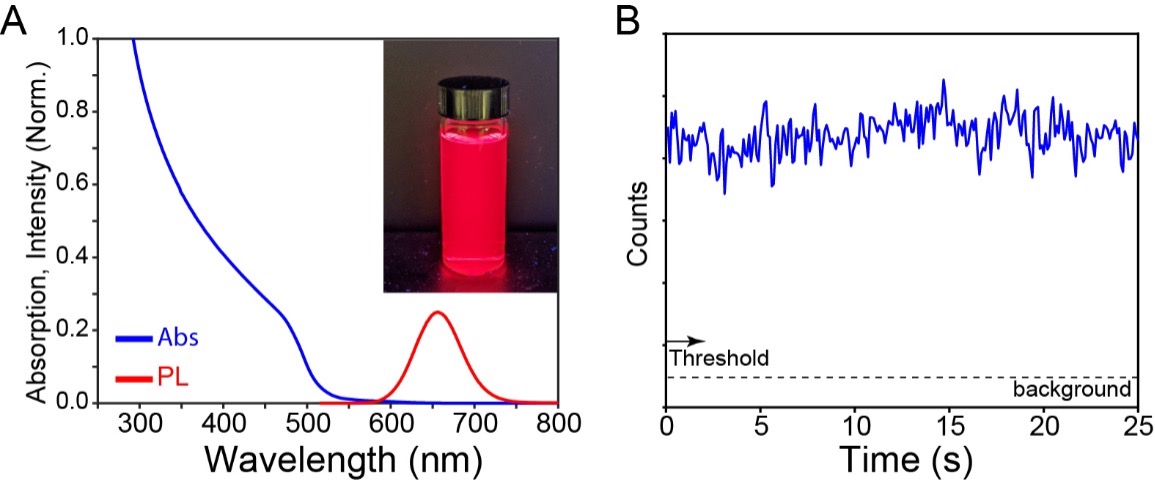| Dec 02, 2022 | |
Type II 'giant' quantum dots have record breaking lifetimes |
|
| (Nanowerk Spotlight) A consortium of research groups led by Prof. Preston Snee of the University of Illinois at Chicago chemistry department with Prof. Haw Yang of Princeton achieved a milestone in the synthesis of multifunctional photonic nanomaterials. They reported the synthesis of semiconductor 'giant' core-shell CdZnSe/CdS quantum dots (gQDs) with record breaking emissive lifetimes. | |
| Furthermore, the lifetimes can be tuned by making a simple alteration to the material’s internal structure. This is accomplished by exciting the ∼20 nm diameter CdZnSe/CdS particle (Figures 1 A,B) with light to put it in the 'exciton' state. | |
| The exciton is an electron / hole charge pair, and in the new materials the electron becomes displaced from the center to the shell where it becomes trapped for upwards of 500 nanoseconds as shown in Figure 1C. This emission lifetime represents the record for such nanomaterials as recently reported in the journal Nano Letters ("Parabolic Potential Surfaces Localize Charge Carriers in Nonblinking Long-Lifetime “Giant” Colloidal Quantum Dots") by the 1st author of the study Dr. Marcell Pálmai. | |
 |
|
| Figure 1. (A) CdZnSe/CdZnS quantum dots have a complex internal structure that separates the electron from the center, which extends the lifetime. (B) TEM analyses help characterize the composition that is composed of a zinc selenide-rich core interior and a cadmium sulfide shell exterior. (C) Time resolved emission reveals tunability by adjusting the size of the CdZnSe core, to achieve lifetimes that can be 10× greater compared to similar, traditional materials. (Image courtesy of the researchers) | |
| As emissive materials, quantum dots hold the promise of creating more energy efficient displays and can be used as fluorescent probes for biomedical research due to their highly robust optical properties. They are 10x to 100x more absorptive than organic dyes and are nearly impervious to photobleaching, which is why they are used in the new Samsung QLED-TV. | |
| The emission wavelength can be tuned by varying the size of the particle as larger QDs are redder than smaller, blue-emitting ones. This is the result of the quantum mechanical Heisenberg Principle. | |
| Tuning the emission lifetime is important as well; however, such a demonstration remained elusive until 2003, when a group at MIT created a semiconductor quantum dot core-shell heterostructure that displayed this capability (Journal of the American Chemical Society, "Type-II Quantum Dots: CdTe/CdSe(Core/Shell) and CdSe/ZinTe(Core/Shell) Heterostructures"). | |
| As in the current example, this was accomplished by separating the electron and hole charge carriers although the lifetime was inextricably linked to the wavelength of emission. As such, long lifetimes could only be observed in the reddest-emitting QDs. | |
| In the new system reported by Pálmai et al. the researchers were able to circumvent this problem to produce a material that can emit at any desired wavelength and with any specific lifetime. | |
 |
|
| Figure 2. (A) Optical data and fluorescent images of lifetime tunable 'giant' quantum dots. (B) Typical single-particle emission trajectory of type II CdZnSe/CdS gQDs shows no blinking behavior. (Image courtesy of the researchers) | |
| The UIC - Princeton consortium accomplished this high level of property tunability by manipulating an aspect of quantum mechanics often taught at the undergraduate level. | |
| Specifically, if the wavefunction of a quantum mechanical electron becomes 'curvy', then the particle’s kinetic energy increases. Consequently, Pálmai et al. designed semiconductor quantum dot heterostructures with a gradient in the electron’s core potential that ends with a sharp discontinuity at the core/shell boundary as shown in Figure 1A. This forces the electron to either localize in the center of the QD with a high kinetic energy 'wavy' wavefunction, or to become sequestered into the shell with a flatter, low kinetic energy wavefunction. As the electron prefers the latter, the group succeeded in localizing the electron without necessarily changing the gQD’s emission wavelength. | |
| These new particles have great efficacy for fundamental biological discovery. The CdZnSe/CdS gQDs presented in their paper (The Journal of Chemical Physics, "Leveraging Lifetime Information to Perform Real-Time 3D Single-Particle Tracking in Noisy Environments") emit at red wavelengths (Figure 2A), which minimizes scattering, while the long lifetimes allow for biological imaging to be performed with less background noise. | |
| At the single particle level the new gQDs emit continuously as shown in Figure 2B, so a research scientist can tag proteins relevant to cancer and follow the biological dynamics without losing track of the signal which is currently a common problem with such studies. For the future the group plans to demonstrate that the materials make good components for optical devices such as micron-sized lasers. | |
| Provided by University of Illinois at Chicago as a Nanowerk exclusive | |
|
Become a Spotlight guest author! Join our large and growing group of guest contributors. Have you just published a scientific paper or have other exciting developments to share with the nanotechnology community? Here is how to publish on nanowerk.com. |
|
